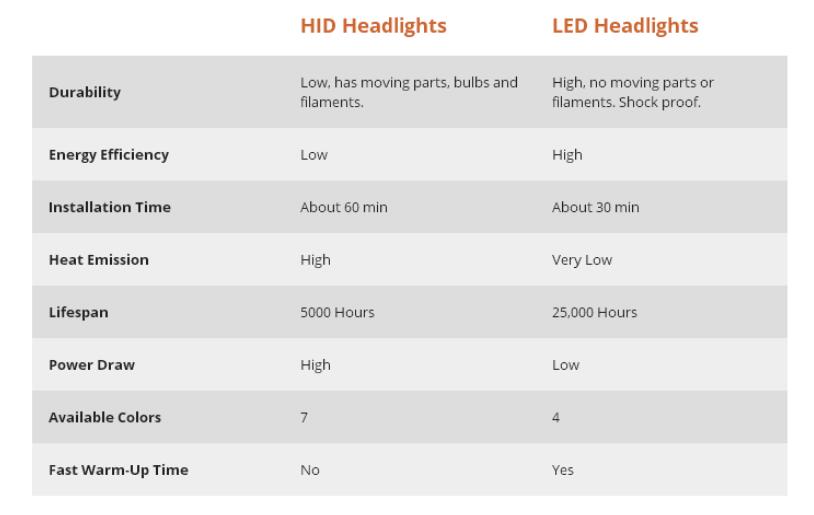www.TrutecLED.com
LED vs HID Headlights - Which Are Better?
Changing your car headlights is a chance to upgrade to something considerably more efficient. Most factory new cars, unmodified, from the last 20 years come with halogen headlights installed as standard.
These are the baseline, and the cheapest component available, so they are used in the mass market to provide the standard quality of headlights we are all familiar with. But technology has come on a long way since these headlights were first developed, and today they are simply too inefficient to compete with the other models available.
Aside from high-end, luxury cars, which are now increasingly coming with more advanced head-lighting installed, road users can easily upgrade their standard headlights to either LED or HID lights, for significantly improved results.
Without getting too stuck in to the technical differences between LEDs and HID headlights, both are capable of producing broad equivalences in terms of vastly stronger, more efficient lighting. The differences come in the way these bulbs are designed and manufactured, and in general the expert preference would always be to choose LEDs over HID headlights.
LED vs HID Headlights Comparison


Understanding HID Headlights
HID headlights, or high-intensity discharge, are a common alternative to halogen bulbs. Instead of halogen, HID headlights use another gas - generally xenon. Passing xenon over an electrical charge allows these bulbs to burn much more brightly than the glowing filament design bulbs, which leads to efficiency savings and improvements in aesthetic and visibility.
These headlights are usually brighter than LEDs and halogens, but they are significantly more fragile, and they are not solid state in the same way as LEDs. This means that HIDs will need replaced much more frequently than LEDs, and in some cases can even burn out before a standard halogen headlight would.
HID headlights are a significant improvement on halogens, and depending on the color temperature, you can choose a light quality that suits your preferences. However, over time, these bulbs can start to burn at lower or higher temperatures, changing the quality of the light they emit, before burning out. HIDs will do a job, but they are problematic over time, and in many respects LEDs represent a more sensible choice for both short and long-term use.
Who Should Use HIDs?
Many people are choosing to upgrade to HIDs, but a certain percentage of them will eventually go on to switch to LEDs. While HIDs are brighter and more efficient than halogens, they are prone to failure over time in a way that LEDs simply aren’t. If you are on a tight budget and you are looking for a quick, short-term fix, you may want to consider HIDs. However, don’t be surprised if you end up changing your headlights several times over the next few years, particularly with so many cheap foreign imports currently flooding the aftermarket.
If you want something longer lasting, and more cost efficient over time while delivering substantial improvements in the quality of your road lighting, you may be better off choosing LED headlights for your car.
LED Headlights Explained
LED lights produce similar improvements to HID headlights, but they go a step further in providing both clear, bright lighting and durability. By 2030, industry estimates project that as much as three quarters, or 75% of all lighting sold will be LED based, and car headlights are no different.
Now that the component costs of LEDs are coming down year on year, more people are choosing to upgrade their headlights to LEDs, and they are not turning back. LED lights use a number of light-emitting diodes to convert electricity from your car into light, with significantly greater efficiency than both HID and halogen bulbs.
Because they are solid state and built to last, these headlights can in theory be used for decades before they will need to be replaced, saving you the ongoing maintenance burden and costs associated with other bulbs.
Furthermore, LED kits can be easily installed on your car, either by yourself or by a professional mechanic in just a few minutes. Once you’ve installed your LED headlights kit, you can expect high quality, warm, white light, illuminating significant portions of the road ahead when compared to basic halogen bulbs.
Who Should Use LEDs
While many motorists want the results that LEDs deliver, some choose other types of bulb in the first instance, like xenon HIDs as a replacement to factory fitted halogen bulbs. If you want low hassle, increased efficiency, strong headlights for your vehicle, you should have no hesitation in opting for LEDs.
Now the headlight of choice for top end and luxury vehicles, motorists worldwide are now waking up to the advantages of LED headlights, and the benefits a retrofit of LEDs can have to any car. LEDs can cost more in the first instance than HIDs or halogens, but over time this pays for itself in lower maintenance and fuel costs long-term.
Upgrading Your Headlights To LEDs
The process of upgrading your headlights doesn’t have to be difficult. With all the benefits of LED headlights available at low cost, and easy installation for even non-technical motorists, an LED kit is an essential investment in the long-term future of your motoring.
Not only will you benefit from better road lighting conditions and increased visibility in all weathers and conditions, but you will also save on fuel and ongoing maintenance costs by upgrading.
Our LED headlight kits are manufactured to precise standards, and guaranteed for the long-term. For more efficiency headlighting, and significantly lower operational costs, there is no better option than LED headlights.
>